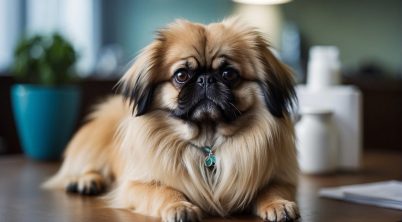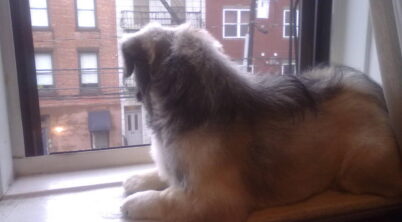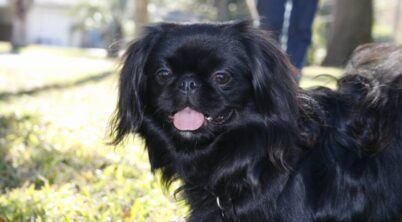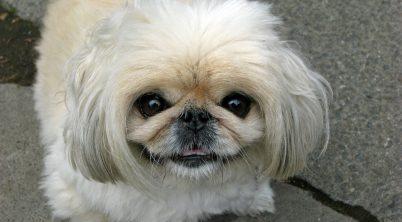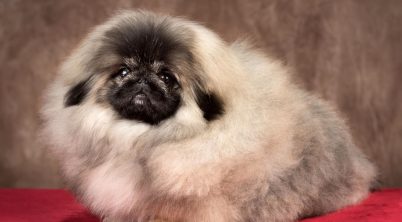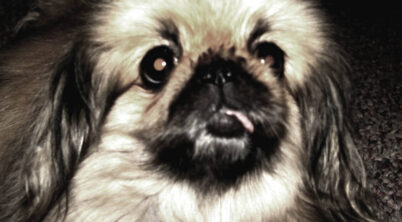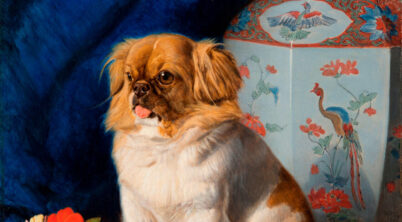Pekingese dogs, with their distinct flat faces and regal manes, are cherished companions known for their loyal and affectionate nature. However, these small canine royals are also predisposed to certain health conditions that can manifest as excessive panting. Normal panting is a typical canine behavior and a primary way dogs regulate their body temperature, as they have fewer sweat glands than humans. This type of open-mouthed breathing is especially common after exercise or in warm environments.
Excessive panting, contrary to normal panting, may indicate an underlying health issue—ranging from heatstroke to respiratory disorders—that requires attention. The Pekingese’s unique physical structure, characterized as brachycephalic, makes them particularly vulnerable to breathing difficulties. This vulnerability necessitates that owners remain vigilant for signs of distress.
It is important for Pekingese owners to understand what constitutes normal panting for their pet, and when panting may be a symptom of a more serious condition. Persistent panting, despite resting or cool temperatures, heavy panting at night, or panting accompanied by additional symptoms like weakness or a deep red tongue, should prompt a consultation with a veterinarian. Recognizing these signs early can help ensure that Pekingese dogs receive appropriate care and maintain a good quality of life.
Table of Contents
Understanding Panting in Pekingese
Panting in Pekingese can be a normal part of their physiology, but excessive panting may indicate an underlying issue. This section will differentiate between typical panting behaviors and those that should raise concern, delve into common causes for excessive panting, and discuss the distinctive anatomy of brachycephalic breeds like the Pekingese.
Normal vs. Abnormal Panting
Normal Panting: Typically, a Pekingese may pant to cool down after exercise or in response to heat, as they lack sweat glands like humans. Normal panting is usually light and not prolonged once the dog is relaxed and cooled down.
Abnormal Panting: It’s characterized by:
- Heavy or constant panting without clear reasons such as exercise or heat.
- Panting accompanied by other symptoms like coughing or fatigue.
- Panting in situations they normally wouldn’t, such as when it’s cool or during rest.
Causes of Excessive Panting
Excessive panting in Pekingese can be attributed to several factors, including:
- Heatstroke: As a brachycephalic breed, Pekingese are more susceptible to heatstroke. Owners should monitor their pets closely for signs of overheating.
- Stress or Anxiety: Pekingese may pant more in stressful situations.
- Health Issues: Conditions such as heart disease, respiratory problems, or even obesity can cause excessive panting.
Anatomy of Brachycephalic Breeds
Pekingese belong to the group of dogs known as brachycephalic breeds. Their anatomy features:
- Shortened Snouts: This trait makes breathing less efficient and sometimes more laborious, contributing to a tendency for panting.
- Smaller Nostrils and Elongated Palates: These can lead to breathing difficulties, further exacerbating the tendency to pant heavily.
Owners should be aware of these anatomical considerations, as they make Pekingese more prone to respiratory challenges and heat intolerance.
Identifying and Addressing Health Issues
Recognizing why a Pekingese may exhibit excessive panting is crucial. This section breaks down the health issues that can cause panting and provides guidance on how to respond effectively.
Common Illnesses Leading to Panting
Pekingese may pant excessively due to several illnesses. Heart disease is known to cause increased respiratory rates and should be monitored closely, especially as Pekingese dogs can be predisposed to this condition. Diseases like heatstroke or respiratory disorders could also be culprits. Signs of brachycephalic syndrome, a condition common in flat-faced breeds, can include heavy panting due to restricted airways.
- Heart Disease
- Increase in respiratory rate
- Potential for coughing
- Respiratory Disorders
- Brachycephalic Syndrome
- Struggling for breath
- Heatstroke
- Excessive panting even at rest
- Possible lethargy
Signs of Pain and Discomfort
Panting may be an indicator of pain or discomfort in a Pekingese. Signs of discomfort can be subtle, such as lethargy or reluctance to play. In more explicit cases, a Pekingese may exhibit a cough or struggle to find a comfortable position to rest due to the pain.
- Lethargy
- Less enthusiasm for exercise
- Decreased response to stimuli
- Coughing
- Especially if it’s persistent or in bouts
- Restlessness
- Frequent position changes
- Inability to settle comfortably
When to Consult a Veterinarian
A veterinarian should be consulted if a Pekingese’s panting is constant, occurs at unusual times, or is accompanied by other distressing symptoms. It is essential to track the dog’s respiratory rate and note any instances of coughing. Early detection of heart disease or other health issues can significantly improve prognosis and quality of life.
- Persistent Panting
- Not associated with physical activity or high temperatures
- Abnormal Signs
- Changes in breathing patterns or sounds
- Coupled with other symptoms like coughing or lethargy
- Regular Checks
- Annual health screenings for early detection of diseases
Treatment and Management
Effective treatment and management of excessive panting in Pekingese dogs requires a combination of veterinary interventions, medications, supplements, and lifestyle modifications. Tailored strategies are essential for addressing the specific causes and symptoms your dog experiences.
Veterinary Interventions
A veterinarian should assess any Pekingese displaying excessive panting to rule out or confirm any health issues. Surgery may be recommended in severe cases, especially to address breathing difficulties associated with brachycephalic obstructive airway syndrome (BOAS). If obesity is contributing to the issue, a weight management plan will be developed.
Medications and Supplements
Depending on the diagnosis, certain medications may be prescribed to treat underlying problems causing the panting, such as respiratory or cardiac conditions. In cases of allergies or skin conditions, appropriate medications can alleviate symptoms. Additionally, supplements might be suggested to support overall health, especially if diet or obesity is a concern.
Lifestyle Changes for Your Dog
Owners can implement various lifestyle changes to help their Pekingese:
- Weight Management: Maintain an ideal weight through a balanced diet and appropriate exercise.
- Environmental Control: Reduce stressors and overstimulation that may lead to anxiety-related panting.
- Comfortable Living Spaces: Ensure the living environment is cool and well-ventilated to help prevent overheating.
These efforts are directed towards enhancing the well-being of the Pekingese and mitigating factors that may exacerbate panting.
Preventing Overheating and Dehydration
The Pekingese breed can be prone to overheating and dehydration, particularly during hot weather conditions. This section provides practical measures that owners can take to prevent these health risks.
Effective Cooling Techniques
Evaporative Cooling: Owners can utilize evaporative cooling methods to help regulate their Pekingese’s body temperature. This includes dampening their dog’s fur with cool water, which then evaporates and helps to cool the dog. Additionally, providing cooling mats or vests specifically designed for dogs can be effective.
Proper Grooming: Regular grooming aids in keeping the Pekingese’s thick coat manageable, which can improve air circulation to the skin and help prevent overheating.
Creating a Safe Environment
Access to Shade: It is crucial to ensure that Pekingese always have access to shaded areas, particularly on hot days. This aids in protecting them from direct sunlight and reduces the risk of heat exhaustion.
Indoor Climate Control: Keeping the Pekingese indoors with air conditioning or fans during peak heat times can significantly reduce the chance of overheating.
Importance of Hydration
Water Availability: Pekingese should always have access to fresh, clean water. On hot days, checking the water supply regularly to ensure it hasn’t run out or become too warm is key.
Recognizing Thirst: Owners should be aware of their Pekingese’s hydration needs and encourage them to drink before, during, and after exposure to heat.
Conclusion
Excessive panting in Pekingese dogs can be symptomatic of various health issues, ranging from temporary overexertion to more serious conditions. Pet owners with Pekingese should pay close attention to their dog’s respiratory patterns and consider the following points:
- Environmental and Behavioral Factors: Panting may occur due to high temperatures or after exercise. Dogs use panting as a mechanism to cool down. This should subside once the dog is rested and in a cooler environment.
- Possible Health Concerns: Persistent panting could indicate health problems such as skin issues, parasitic infections, pulmonary fibrosis, or endocrine disorders. Any change in the dog’s normal panting pattern warrants attention.
- Medication Side Effects: Certain medications, like steroids, can cause increased panting. It is important to discuss potential side effects with a veterinarian when new medications are prescribed.
- When to See a Vet: If a Pekingese is panting excessively while at rest, experiencing changes in normal panting behavior, or showing other concerning symptoms, it is crucial to seek veterinary care.
Owners should be proactive in managing their Pekingese’s health by maintaining regular veterinary check-ups and being observant of their pet’s breathing patterns. By staying informed and attentive, they can ensure that any necessary medical interventions are timely, thereby enhancing their dog’s quality of life.

